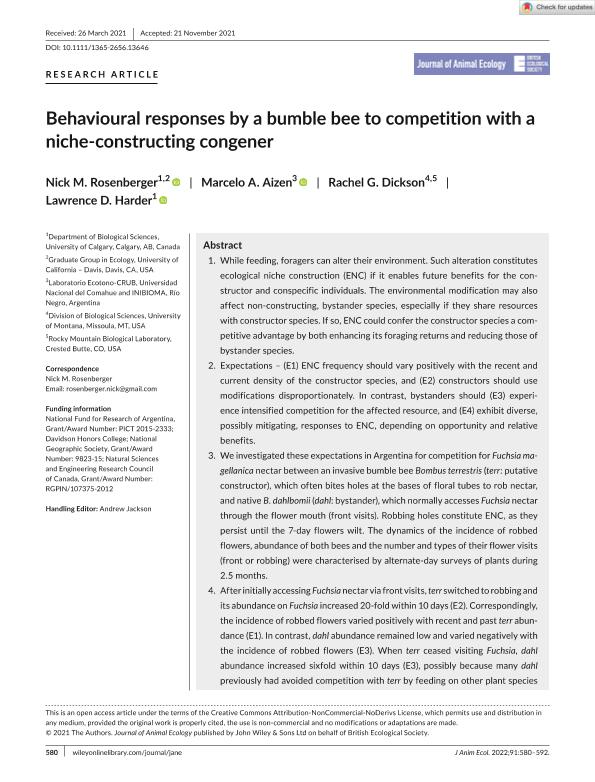Mostrar el registro sencillo del ítem
dc.contributor.author
Rosenberger, Nick M.
dc.contributor.author
Aizen, Marcelo Adrian

dc.contributor.author
Dickson, Rachel G.
dc.contributor.author
Harder, Lawrence

dc.date.available
2024-03-22T10:39:39Z
dc.date.issued
2022-03
dc.identifier.citation
Rosenberger, Nick M.; Aizen, Marcelo Adrian; Dickson, Rachel G.; Harder, Lawrence; Behavioural responses by a bumble bee to competition with a niche-constructing congener; Wiley Blackwell Publishing, Inc; Journal Of Animal Ecology; 91; 3; 3-2022; 580-592
dc.identifier.issn
0021-8790
dc.identifier.uri
http://hdl.handle.net/11336/231254
dc.description.abstract
While feeding, foragers can alter their environment. Such alteration constitutes ecological niche construction (ENC) if it enables future benefits for the constructor and conspecific individuals. The environmental modification may also affect non-constructing, bystander species, especially if they share resources with constructor species. If so, ENC could confer the constructor species a competitive advantage by both enhancing its foraging returns and reducing those of bystander species. Expectations – (E1) ENC frequency should vary positively with the recent and current density of the constructor species, and (E2) constructors should use modifications disproportionately. In contrast, bystanders should (E3) experience intensified competition for the affected resource, and (E4) exhibit diverse, possibly mitigating, responses to ENC, depending on opportunity and relative benefits. We investigated these expectations in Argentina for competition for Fuchsia magellanica nectar between an invasive bumble bee Bombus terrestris (terr: putative constructor), which often bites holes at the bases of floral tubes to rob nectar, and native B. dahlbomii (dahl: bystander), which normally accesses Fuchsia nectar through the flower mouth (front visits). Robbing holes constitute ENC, as they persist until the 7-day flowers wilt. The dynamics of the incidence of robbed flowers, abundance of both bees and the number and types of their flower visits (front or robbing) were characterised by alternate-day surveys of plants during 2.5 months. After initially accessing Fuchsia nectar via front visits, terr switched to robbing and its abundance on Fuchsia increased 20-fold within 10 days (E2). Correspondingly, the incidence of robbed flowers varied positively with recent and past terr abundance (E1). In contrast, dahl abundance remained low and varied negatively with the incidence of robbed flowers (E3). When terr ceased visiting Fuchsia, dahl abundance increased sixfold within 10 days (E3), possibly because many dahl previously had avoided competition with terr by feeding on other plant species (E4). While terr was present, dahl on Fuchsia used front visits (tolerance) or used existing robbing holes (adoption: E4). The diverse dahl responses suggest partial compensation for competition with terr. ENC alters competitive asymmetry, favouring constructor species. However, bystander responses can partially offset this advantage, perhaps facilitating coexistence.
dc.format
application/pdf
dc.language.iso
eng
dc.publisher
Wiley Blackwell Publishing, Inc

dc.rights
info:eu-repo/semantics/openAccess
dc.rights.uri
https://creativecommons.org/licenses/by-nc-nd/2.5/ar/
dc.subject
BUMBLE BEE
dc.subject
ECOLOGICAL NICHE CONSTRUCTION
dc.subject
EXPLOITATION COMPETITION
dc.subject
INVASIVE SPECIES
dc.subject
NECTAR ROBBING
dc.subject
SOUTHERN SOUTH AMERICA
dc.subject.classification
Ecología

dc.subject.classification
Ciencias Biológicas

dc.subject.classification
CIENCIAS NATURALES Y EXACTAS

dc.title
Behavioural responses by a bumble bee to competition with a niche-constructing congener
dc.type
info:eu-repo/semantics/article
dc.type
info:ar-repo/semantics/artículo
dc.type
info:eu-repo/semantics/publishedVersion
dc.date.updated
2023-06-29T10:34:34Z
dc.identifier.eissn
1365-2656
dc.journal.volume
91
dc.journal.number
3
dc.journal.pagination
580-592
dc.journal.pais
Reino Unido

dc.journal.ciudad
Londres
dc.description.fil
Fil: Rosenberger, Nick M.. University of Calgary. Departament of Biological Sciences; Canadá. University of California; Estados Unidos
dc.description.fil
Fil: Aizen, Marcelo Adrian. Consejo Nacional de Investigaciones Científicas y Técnicas. Centro Científico Tecnológico Conicet - Patagonia Norte. Instituto de Investigaciones en Biodiversidad y Medioambiente. Universidad Nacional del Comahue. Centro Regional Universidad Bariloche. Instituto de Investigaciones en Biodiversidad y Medioambiente; Argentina
dc.description.fil
Fil: Dickson, Rachel G.. University of Montana; Estados Unidos. Rocky Mountain Biological Laboratory; Estados Unidos
dc.description.fil
Fil: Harder, Lawrence. University of Calgary. Departament of Biological Sciences; Canadá
dc.journal.title
Journal Of Animal Ecology

dc.relation.alternativeid
info:eu-repo/semantics/altIdentifier/url/https://besjournals.onlinelibrary.wiley.com/doi/10.1111/1365-2656.13646
dc.relation.alternativeid
info:eu-repo/semantics/altIdentifier/doi/https://doi.org/10.1111/1365-2656.13646
Archivos asociados
